Abstract
Serial serum samples from fifteen patients with SLE, taken over periods varying from 6 months to 6 years, were tested for DNA binding capacity, DNA electroprecipitins (DNA-EP) and C'3 level to assess the value of these investigations in reflecting clinical disease activity. Patients with renal involvement showed a good correlation between high levels of DNA binding, low serum C'3 and disease activity and typically, their DNA-EP was negative. By contrast, patients without renal involvement in whom vasculitis was prominent, showed a poor correlation of DNA binding capacity to changes in the state of their disease although the DNA-EP test was persistently positive. It was also apparent that both the DNA-BC and C'3 can show marked variation in response to alterations in treatment without accompanying clinical change. Although these serological tests, particularly the DNA binding capacity are of recognized value in the diagnosis of SLE, they serve most usefully as guides to long-term management when they can be related to the clinical pattern of the disease.
Full text
PDF






Selected References
These references are in PubMed. This may not be the complete list of references from this article.
- CEPPELLINI R., POLLI E., CELADA F. A DNA-reacting factor in serum of a patient with lupus erythematosus diffusus. Proc Soc Exp Biol Med. 1957 Dec;96(3):572–574. doi: 10.3181/00379727-96-23544. [DOI] [PubMed] [Google Scholar]
- Carr R. I., Koffler D., Agnello V., Kunkel H. G. Studies on DNA antibodies using DNA labelled with actinomycin-D (3H) or dimethyl (3H) sulphate. Clin Exp Immunol. 1969 May;4(5):527–536. [PMC free article] [PubMed] [Google Scholar]
- Cohen A. S., Canoso J. J. Criteria for the classification of systemic lupus erythematosus--status 1972. Arthritis Rheum. 1972 Sep-Oct;15(5):540–543. doi: 10.1002/art.1780150512. [DOI] [PubMed] [Google Scholar]
- FARR R. S. A quantitative immunochemical measure of the primary interaction between I BSA and antibody. J Infect Dis. 1958 Nov-Dec;103(3):239–262. doi: 10.1093/infdis/103.3.239. [DOI] [PubMed] [Google Scholar]
- Hughes G. R., Cohen S. A., Christian C. L. Anti-DNA activity in systemic lupus erythematosus. A diagnostic and therapeutic guide. Ann Rheum Dis. 1971 May;30(3):259–264. doi: 10.1136/ard.30.3.259. [DOI] [PMC free article] [PubMed] [Google Scholar]
- Johnson G. D., Edmonds J. P., Holborow E. J. Precipitating antibody to D.N.A. detected by two-stage electroimmunodiffusion. Study in S.L.E. and in rheumatoid arthritis. Lancet. 1973 Oct 20;2(7834):883–885. doi: 10.1016/s0140-6736(73)92008-4. [DOI] [PubMed] [Google Scholar]
- Jokinen E. J., Julkunen H. DNA haemagglutination test in the diagnosis of systemic lupus erythematosus. Ann Rheum Dis. 1965 Sep;24(5):477–480. doi: 10.1136/ard.24.5.477. [DOI] [PMC free article] [PubMed] [Google Scholar]
- Koffler D., Carr R. I., Agnello V., Fiezi T., Kunkel H. G. Antibodies to polynucleotides: distribution in human serums. Science. 1969 Dec 26;166(3913):1648–1649. doi: 10.1126/science.166.3913.1648. [DOI] [PubMed] [Google Scholar]
- MIESCHER P., STRASSLE R. New serological methods for the detection of the L.E. factor. Vox Sang. 1957 Sep;2(4):283–287. doi: 10.1111/j.1423-0410.1957.tb03704.x. [DOI] [PubMed] [Google Scholar]
- ROBBINS W. C., HOLMAN H. R., DEICHER H., KUNKEL H. G. Complement fixation with cell nuclei and DNA in lupus erythematosus. Proc Soc Exp Biol Med. 1957 Dec;96(3):575–579. doi: 10.3181/00379727-96-23545. [DOI] [PubMed] [Google Scholar]
- SELIGMANN M. Mise en évidence dans le sérum de malades atteints de lupus erythémateux disséminé d'une substance déterminant une réaction de précipitation avec l'acide désoxyribonucléique. C R Hebd Seances Acad Sci. 1957 Jul 8;245(2):243–245. [PubMed] [Google Scholar]
- Schur P. H., Sandson J. Immunologic factors and clinical activity in systemic lupus erythematosus. N Engl J Med. 1968 Mar 7;278(10):533–538. doi: 10.1056/NEJM196803072781004. [DOI] [PubMed] [Google Scholar]
- Soothill J. F., Steward M. W. The immunopathological significance of the heterogeneity of antibody affinity. Clin Exp Immunol. 1971 Aug;9(2):193–199. [PMC free article] [PubMed] [Google Scholar]
- Tan E. M., Schur P. H., Carr R. I., Kunkel H. G. Deoxybonucleic acid (DNA) and antibodies to DNA in the serum of patients with systemic lupus erythematosus. J Clin Invest. 1966 Nov;45(11):1732–1740. doi: 10.1172/JCI105479. [DOI] [PMC free article] [PubMed] [Google Scholar]
- Wold R. T., Young F. E., Tan E. M., Farr R. S. Deoxyribonucleic acid antibody: a method to detect its primary interaction with deoxyribonucleic acid. Science. 1968 Aug 23;161(3843):806–807. doi: 10.1126/science.161.3843.806. [DOI] [PubMed] [Google Scholar]


